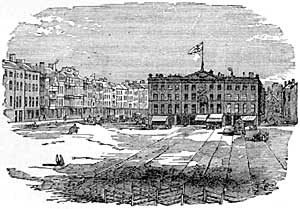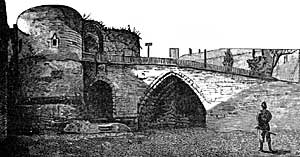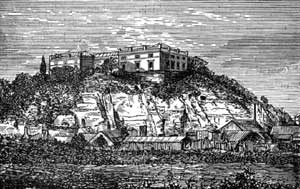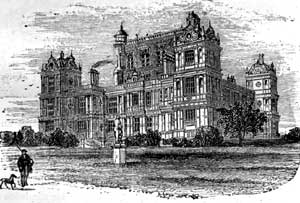The tram, at its terminus at the Trent Bridge, should be utilized for the journey to the "town' '—fare, one penny. This will convey passengers to the St. Peter's-square terminus. On the right-hand side of Arkwright-street is St. Saviour's Church, in the Early Decorated style, built of a local (Bulwell) stone; with Ancaster dressings, complete in its members, and with accommodation for seven hundred worshippers. On the left-hand side, a little distance beyond, at the rise of the incline to the railway bridge, is Queen's-walk, a rate-maintained public tree-lined walk, three-quarters of a mile in length, the end of which is close to Wilford Bridge, to which reference has already been made. At the entrance to this walk is a statue, in stone, of the late Sir Robert Juckes Clifton, Bart., a popular Member of Parliament,who died May 30, 1869. The statue was unveiled May 24, 1883,and was the work of a Nottingham sculptor, Mr. Ph. Smith. The bridge just spoken of crosses the Midland Railway. The Goods Office, a good polished stone building, is on the same side of the street, just over the bridge; and opposite is Station—street, with its two railway stations and the extensive buildings (opposite the Midland Station) of thc Nottingham Manufacturing Company—one among many illustratioas of the commercial importance of the town.
Still on the left-hand of the journey—now in Carrington-street—visitors may notice Collin's Hospital, for persons in reduced circumstances, one of a numerous class of similar benevolent institutions with which the town is ornamented. This group of twenty houses was erected in 1830 and 1834, upon the site of the old Greyfriars' Gate. In close proximity to the north end of the hospital grounds is the handsome Gothic Walter Memorial Fountain. This is of stone, is octagonal in plan, and about fifty feet high. It was erected in 1865-6, at a cost of £1000, by Mr. John Walter, to the memory of his father, of Times celebrity, who was M.P. for this town 1847-57. It consists of a drinking-fountain, with two medallions of Mr. Walter, of Bearwood. It was designed by Mr. Councillor R. C. Sutton, and is of the "Eleanor-Cross" order. The continuation of the street is Lister-gate, widened in 1864, one of the best thoroughfares of the town. The hilly street on the right is the Low-pavement, in which are located the Assembly Rooms, a commodious structure of the Corinthian order of architecture; and the Savings Bank, erected in 1837. On the opposite side of Lister-gate is Castle-gate, in which are the Congregational Chapel, one of the finest and most commodious of the nonconformist places of worship in Nottingham, which is in the Lombardo-Venetian style; the Women's Hospital, opened in 1875; and St. Nicholas' Church (near the Castle, of which more anon), a brick structure, built soon after the Civil Wars of the 17th century, the former one having been demolished by the cannon of the Castle. Albert-street—which runs into St. Peter's-square, and is a continuation, in almost a straight line, of the Arkwright-street approach of the Trent Bridge—is now reached, with its lofty shops, and the Municipal Offices, formerly the Post Office, erected in 1848. The Medical Officer of Health and the Sanitary officers and clerks, and the rate collectors have offices here—the Town Clerk and Borough Engineer are to be located in the new municipal buildings—the Guild Hall—in South Sherwood-street.
St. Peter's Church is close to this public building and to tile tram terminus. St. Peter's is a structure with a graceful spire, and dates from the time of Henry V. ; has a sweet peal of eight bells; and contains a valuable painting of "The Agony," by Barber, a native artist of more than local fame. The vestry was battered down by the Parliamentarian soldiers in 1644, in order to drive some Newark Royalists therefrom. St. Peter's has very recently been re-pewed, and in other respects the interior has been greatly improved in appearance. The grave-yard, previous to this restoration, was curtailed, in order that St. Peter's-gate might be widened to its present extent. On the left-hand side of this "gate" are the Water and the Borough Accountant s Offices, a substantial stone building, the former being on the ground floor, and the latter on the first floor. It was designed by a Pugin. Next to this is the County Court, another stone edifice— erected within about the last twenty years.

MARKET PLACE.
Opposite the steeple-end of St. Peter's Church is Hounds-gate and in continuation of the tram route is a newly-widened thoroughfare—Wheeler-gate, with its handsome new shops, leading to The GREAT MARKET PLACE. This immense open area is, perhaps, the most distinctive feature of the whole town, and the inhabitants very justly boast that it is "the largest in England." It is well paved, and occupies a triangular area of about five and a half acres. Leland, who wrote in the reign of Henry VIII., says, "both for the buildings on the side of it, for the very great wideness of the streets, and the clean paving of it, it is the fairest without exception of all England." It is now surrounded with lofty and well-built houses, the fronts of which project over the basement storey, and being supported by pillars, form long piazzas, under which are shops. The range of buildings on the north side is upwards of 400 yards in length, and is called the Long-row. The houses and shops on the south side bear the name of Angel-row, the Beast-market-hill, the Poultry, and South-parade. At the east end, betwixt the Long-row and the Poultry, is a centre pile of building, the west end of which presents to the Market-place the spacious front of the Exchange. This building is of but slight architectural pretensions. The large room, which is 75 feet by 30, was formerly used for Public Meetings, Concerts, &c., but is now furnished as a Municipal Council Chamber. A small portion of "The Exchange" is reserved for the accommodation of the Mayor, and is styled the Mayor's Parlour. The Butchers' Shambles occupy part of the ground space; the remainder being used for other trading purposes. On Wednesdays and Saturdays the whole extensive area of the Market-place is occupied with stalls of provisions, fish, fruit, vegetables, furniture, earthenware, &c.
Leaving the Market Place (to be seen at a later stage), visitors should proceed along Friar-lane—to the left of Wheeler-gate, and in a line with South-parade—for a tour of inspection of art treasures, public buildings, &c. The Gothic stuccoed and painted structure on the left-hand side, standing a little back, is anIndependent Chapel. On the opposite side of the street, a little distance beyond, is an appropriately plain brick building—The Friends' Meeting House and Schools.In close proximity is a building of an unmistakeable ancient appearance, the original Collins’ Hospital, the history of which is inscribed upon a tablet over one of the entrances. Facing the end of this thoroughfare—Park-street—is the time-worn gateway of Nottingham Castle.

ANCIENT ARCHWAY.
Before, however, proceeding to it, visitors would do well to see the ancient archways which support the roadway to the gateway (of which an illustration is here given), and the Drill Hall of the famous Robin Hood Rifle Volunteer Corps (opened in 1874), which faces, and which was formerly used as a Riding School.
The Castle grounds are now tastefully laid-out, and the "Castle" itself (having been restored by the Corporation and Subscribers) is utilized as a Fine Art Gallery and Museum— a visit to which is well worthy of a journey of many miles—with its eleven rooms of pictures and objects of fine and industrial art. Our illustration is of the aspect presented from "the Meadows." The charge for admission is posted up at the inner gates.

THE CASTLE.
Visitors to the Castle should approach by the carriage drive by the lawn, where an extensive view of The Park—a fashionable and beautifully situated residential district—is generally to be obtained. The best, entrance is the further one. The stairs should be mounted and the upper rooms examined, when the lower rooms (approached by the North staircase) should be traversed. [The first storey is devoted to works of pictorial art executed in oil, water colours, &c. whilst the ground floor is assigned to objects of fine and industrial art, and consist of porcelain, pottery, glass, carvings in various materials, metal work in great variety, electrotype reproductions, textile-fabrics, laces, coins, and medals, arms, local antiquities, &c.] This done, visitors may obtain refreshments. The Terrace, to which access is gained by passing through the Refreshment Room, should next engage attention, because of the extensive and varied panoramic view which is to be obtained from this position.

WOLLATON HALL.
To the right, at a distance of nearly two miles, on the Derby-road, is Wollaton Hall, the fine Elizabethan residence of Lord Middleton ; "the silvery winding Trent;" Wilford Church, embowered in trees; Clifton Grove, a resort of Kirke White, up the hill beyond; whilst to the left, on a favourable day, may be seen, far away, Belvoir Castle, the baronial home of the Duke of Rutland. A still finer and wider view of this great stretch of country is obtained from the Castle roof, to which there is admission on payment of a small fee.
